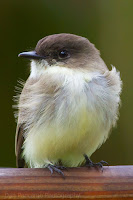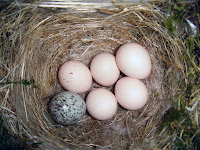EASTERN PHOEBE
EASTERN PHOEBE – (Sayornis phoebe) – (See images below)
DESCRIPTION: The Eastern Phoebe has a dark grey-brown head with a sometimes visible crest. The upper parts are grey and the under parts generally white. There are two faint wing bars. It has a plump body shape. The bill and legs are dark grey, and the eyes are black. The bird wags its tail up and down when perched. Sexes are similar. This bird is about 15 cm (6 inches) long.
VOICE: https://www.xeno-canto.org/species/Sayornis-phoebe
NAME: The English name ‘Phoebe’ is an onomatopoeia for the bird’s call. The Latin genus name ‘Sayornis’ comes from ‘Say’ and ‘ornis’ (Greek for ‘bird’). Thomas Say was an American entomologist and this species was named in his honor.
HABITAT: Open forest with some wetland or water nearby.
DIET: Perches on a post or on top of a tree and waits for an insect to fly by. Catches it mid-air and returns to its perch. Will also feed on spiders and other invertebrates on the ground, and berries and seeds when available.
NESTING: Natural setting locations: on rocks with some under story vegetation nearby. Human-made nesting locations: under or on structures such as bridges, buildings, even large culverts. For the nest to adhere to smooth or vertical surfaces, the bird uses mud mixed with plant material and animal hair. Between two and five eggs are laid, incubated by . Both parents feed the chicks. The nest is a target of the parasitic Brown-headed Cowbird.
DISTRIBUTION: Breeds in Canada up to Yukon except in the Rockies and only in southern Quebec, and most of the eastern half of the USA. The northernmost population that migrates for the winter will spend that season in the southeast part of the USA, and the northeast part of Mexico.
DISTRIBUTION MAP: https://en.wikipedia.org/wiki/Eastern_phoebe#/media/File:Sayornis_phoebe_map.svg
ON PEI: The eastern phoebe does not breed on Prince Edward Island, and there have only been rare or uncommon sightings of this bird so far throughout the seasons except winter.
CONSERVATION: Numbers of the eastern phoebe appear stable in spite of their nests sometimes being removed from structures. That species’ inclination for nesting on structures helps make up for other threats such as nest parasitism by the Brown-headed Cowbird (see photo below).
NOTES: The eastern phoebe is part of the Flycatcher family.
SIMILAR SPECIES: Eastern Wood Pewee, Say’s Phoebe
REFERENCES: https://www.thespruce.com/eastern-phoebe-3571721
https://www.borealbirds.org/bird/eastern-phoebe
https://www.mba-aom.ca/jsp/toc.jsp (Maritimes Breeding Bird Atlas)
http://www.oiseaux-birds.com/card-eastern-phoebe.html
https://www.audubon.org/field-guide/bird/eastern-phoebe
https://www.allaboutbirds.org/guide/Eastern_Phoebe/id
https://nature.mdc.mo.gov/discover-nature/field-guide/eastern-phoebe (Missouri Department of Conservation)
DESCRIPTION: The Eastern Phoebe has a dark grey-brown head with a sometimes visible crest. The upper parts are grey and the under parts generally white. There are two faint wing bars. It has a plump body shape. The bill and legs are dark grey, and the eyes are black. The bird wags its tail up and down when perched. Sexes are similar. This bird is about 15 cm (6 inches) long.
VOICE: https://www.xeno-canto.org/species/Sayornis-phoebe
NAME: The English name ‘Phoebe’ is an onomatopoeia for the bird’s call. The Latin genus name ‘Sayornis’ comes from ‘Say’ and ‘ornis’ (Greek for ‘bird’). Thomas Say was an American entomologist and this species was named in his honor.
HABITAT: Open forest with some wetland or water nearby.
DIET: Perches on a post or on top of a tree and waits for an insect to fly by. Catches it mid-air and returns to its perch. Will also feed on spiders and other invertebrates on the ground, and berries and seeds when available.
NESTING: Natural setting locations: on rocks with some under story vegetation nearby. Human-made nesting locations: under or on structures such as bridges, buildings, even large culverts. For the nest to adhere to smooth or vertical surfaces, the bird uses mud mixed with plant material and animal hair. Between two and five eggs are laid, incubated by . Both parents feed the chicks. The nest is a target of the parasitic Brown-headed Cowbird.
DISTRIBUTION: Breeds in Canada up to Yukon except in the Rockies and only in southern Quebec, and most of the eastern half of the USA. The northernmost population that migrates for the winter will spend that season in the southeast part of the USA, and the northeast part of Mexico.
DISTRIBUTION MAP: https://en.wikipedia.org/wiki/Eastern_phoebe#/media/File:Sayornis_phoebe_map.svg
ON PEI: The eastern phoebe does not breed on Prince Edward Island, and there have only been rare or uncommon sightings of this bird so far throughout the seasons except winter.
CONSERVATION: Numbers of the eastern phoebe appear stable in spite of their nests sometimes being removed from structures. That species’ inclination for nesting on structures helps make up for other threats such as nest parasitism by the Brown-headed Cowbird (see photo below).
NOTES: The eastern phoebe is part of the Flycatcher family.
SIMILAR SPECIES: Eastern Wood Pewee, Say’s Phoebe
REFERENCES: https://www.thespruce.com/eastern-phoebe-3571721
https://www.borealbirds.org/bird/eastern-phoebe
https://www.mba-aom.ca/jsp/toc.jsp (Maritimes Breeding Bird Atlas)
http://www.oiseaux-birds.com/card-eastern-phoebe.html
https://www.audubon.org/field-guide/bird/eastern-phoebe
https://www.allaboutbirds.org/guide/Eastern_Phoebe/id
https://nature.mdc.mo.gov/discover-nature/field-guide/eastern-phoebe (Missouri Department of Conservation)
 |
| Eastern phoebe, WI, by John Benson |
 |
| Eastern phoebe, WI, by John Benson |
 |
| Eastern phoebe, Dan Pancamo |
 |
| Eastern phoebe nest with a Brown- headed cowbird egg, Gaawebdesign |